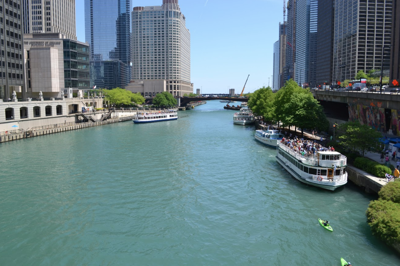By Brian Zarley | Staff Writer
Patience, planning and keeping your head on a swivel—according to Chief Warrant Officer Matthew James, commanding officer of the Coast Guard Station Calumet Harbor, that’s what boaters need to remember to safely navigate the Chicago River.
That, and their life jackets. While the constant stream of boats can seem chaotic and intimidating, there is a method to the madness.
“If you basically picture it like a big highway, that’s generally what the river breaks down to,” said Captain Gabe Argumedo, who has been piloting Chicago’s First Lady on the river for 10 years, and working on it for 14. “The most important thing on the river is to keep that traffic flowing.”
Whether going up or down the river, boaters should keep to the right—or starboard—side. Slower traffic and smaller vessels should stay further right allowing the larger, faster commercial vessels to safely pass them. This also frees up the slightly deeper middle of the river for larger vessels. Unless in an emergency, boaters should not drop anchor. Keeping the boats moving helps ensure a safe and efficient flow for everyone on the river.
While traveling, boaters need to maintain a safe speed—the river is a no-wake zone—and pay attention to the flow of traffic around them. “You shouldn’t be going so fast that you can’t stop your vessel and avoid a collision if one became imminent,” James said.
The locks have an order for loading, Argumedo said. Commercials vessels are first priority, followed by government, recreational, and then cargo and fishing boats.
Boaters should wait to the north side of the turning basin for the lock chambers to clear. A system of signal lights—red means no traffic; yellow means commercial vessels may enter; green means recreational vessels can enter—tells boaters when to steam into the basin. Recreational boaters should be aware that the current is particularly strong this year, especially going from the river to the lake, due to the difference in water level, Argumedo said.
Life jackets are required once a boat enters the locks. The Coast Guard strongly recommends their use at all times, especially with the cold waters of the river and Lake Michigan. “We try to draw the equivalent between a life jacket and a seatbelt,” James said.
Navigation lights are crucial for safely traveling on the river, even with the bright lights of downtown. In fact, the glare and abundance of light sources can make spotting a boat—or a boat’s lights—even more difficult.
“They’re extremely important,” Argumedo said. “That is going to tell us exactly what kind of a boat, or what direction they are going, versus not having lights at all.”
With common sense, traffic awareness and vessel vigilance, boaters can make the most of their time on the water.
Published June 5, 2018








(0) comments
Welcome to the discussion.
Log In
Keep it Clean. Please avoid obscene, vulgar, lewd, racist or sexually-oriented language.
PLEASE TURN OFF YOUR CAPS LOCK.
Don't Threaten. Threats of harming another person will not be tolerated.
Be Truthful. Don't knowingly lie about anyone or anything.
Be Nice. No racism, sexism or any sort of -ism that is degrading to another person.
Be Proactive. Use the 'Report' link on each comment to let us know of abusive posts.
Share with Us. We'd love to hear eyewitness accounts, the history behind an article.